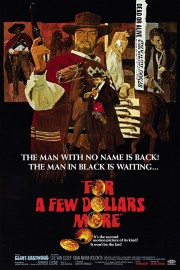For a Few Dollars More
The first shot of Sergio Leone’s “For a Few Dollars More” is emblematic of the director’s approach in not only his trilogy with Clint Eastwood but also his “Once Upon a Time in the West.” The film opens with a wide shot of a man on a horse. We hear a rifleman prepare off-screen. He shoots, without ever being seen as we watch the horse rattled and running away in the distance as the credits role, and Ennio Morricone’s legendary music kicks into high gear. What you notice in Leone’s films is that he is more interested in style than story. All we need of the latter is a compelling one, even if it’s relatively simple. What movies should be more interested in are showing us sights we’ve never seen before. With all four of the films I’ve seen of his, this idea is what drives the narrative.
With “For a Few Dollars More,” the narrative begins with a mysterious man in black (whom we will learn is Col. Mortimer, played by Lee Van Cleef, whose eyes always look sinister and serious) getting off a train in the dusty town of Tucumcari. He’s in town to find a man wanted by the law. He finds his man, and shoots him dead. He’s a bounty hunter. As he’s collecting his money, he asks about another bounty, and hears that someone else has inquired about the same man. This turns out to be Eastwood’s Manco, a variation on the character he played in “A Fistful of Dollars.” The two will eventually find themselves hunting another fugitive who just escaped from jail– the deadly “El Indio” (Gian Maria Volonte) and his gang. But as the story moves forward, the two will find that working together will be more beneficial than working against one another in bringing in this killer.
Ennio Morricone’s music plays an even greater role in this film than it did in “A Fistful of Dollars.” The most significant part of the score is in the music that emanates from El Indio’s pocketwatch, first heard when he is in a showdown with the man who sent him to prison. The music is haunting, poignant, and unforgettable, and in the aforementioned showdown Morricone also has organs and guitars to add suspense and tension to the scene. It’s a tour de force of film music that paved the way for Morricone’s later masterpieces, “Once Upon a Time in the West” and of course, “The Good, the Bad and the Ugly.”
It isn’t just the music that is heightened in “For a Few Dollars More.” Working from a script by Luciano Vincenzoni, Leone is looking to explore deeper emotional territory than he did in “Fistful.” The music from Indio’s pocketwatch has poignance for the killer, reminding him of the wife he lost. And as the story goes along, the relationship between young gunslinger Manco and the older Mortimer is less about rivalry and more about the older bounty hunter passing on his wisdom to a young and reckless desparado who could live longer for taking heed.
Still, it’s all about the sights and sounds with Leone. Eastwood and that poncho and that cigar. Van Cleef with those ruthless eyes. The two bounty hunters shooting at one another’s hats in the middle of town. German wildman Klaus Kinski and that hunchback. The unforgiving Spanish vistas Leone found his inspiration in. The mesmerizing musical landscapes Morricone created. The weathered faces of the desparados. And the excitement of watching a new type of Old West unfold before our eyes…and the best was yet to come.










